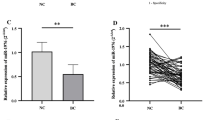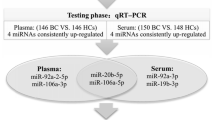Abstract
The present study was to evaluate the value of miRNA-30a in plasma as potential tumor marker in detecting breast cancer (BC). Using a novel approach to extract miRNA-30a from the plasma followed by real-time quantitative polymerase chain reaction (RQ-PCR) analysis, levels of miRNA-30a were quantified in plasma specimens of 100 BCs and 64 age-matched and disease-free healthy controls (HC). And we compared the diagnostic value of plasma miRNA-30a with conventional circulating tumor markers CA153 and CEA. The median levels of miRNA-30a were significantly lower in preoperative BC than those in HC (P < 0.001). The levels of CEA and CA153 were all significantly higher in preoperative BC compared with those in HC (P = 0.008 and P = 0.001, respectively), and only the level of CA153 decreased in postoperative BC compared with preoperative BC (P = 0.015). ROC analysis showed the sensitivity and specificity of miRNA-30a for BC diagnosis at 74.0 and 65.6 %, respectively, whereas the sensitivities of CEA and CA153 were 12.0 and 14.0 %, respectively. The status of ER and triple-negative BC was significantly associated with miRNA-30a level (P = 0.007 and P = 0.005, respectively). And no other clinicopathological features were found to had significant difference. Our findings suggest that plasma miRNA-30a decreased in patients with BC and has great potential to use as novel biomarkers for BC diagnosis.



Similar content being viewed by others
Abbreviations
- HC:
-
Healthy controls
- CEA:
-
Carcinoembryonic antigen
- CA153:
-
Carbohydrate antigen 153
- TNM:
-
Tumor-node-metastasis
- AJCC:
-
American Joint Committee on Cancer
- ROC:
-
Receiver operator characteristic
- ER:
-
Estrogen receptor
- LNM:
-
Lymph node metastasis
- BC:
-
Breast cancer
- RQ-PCR:
-
Real-time quantitative polymerase chain reaction
- DCIS:
-
Ductal carcinoma in situ
References
Taplin S, Abraham L, Barlow WE, Fenton JJ, Berns EA, Carney PA, et al. Mammography facility characteristics associated with interpretive accuracy of screening mammography. J Natl Cancer Inst. 2008;100(12):876–87.
Screening for breast cancer. U.S. preventive services task force recommendation statement. Ann Intern Med. 2009;151(10):716–26. W-236.
Mandelblatt JS, Cronin KA, Bailey S, Berry DA, de Koning HJ, Draisma G, et al. Effects of mammography screening under different screening schedules: model estimates of potential benefits and harms. Ann Intern Med. 2009;151(10):738–47.
O’Hanlon DM, Kerin MJ, Kent P, Maher D, Grimes H, Given HF. An evaluation of preoperative CA 15–3 measurement in primary breast carcinoma. Br J Cancer. 1995;71(6):1288–91.
Uehara M, Kinoshita T, Hojo T, Akashi-Tanaka S, Iwamoto E, Fukutomi T. Long-term prognostic study of carcinoembryonic antigen (CEA) and carbohydrate antigen 15–3 (CA 15–3) in breast cancer. Int J Clin Oncol. 2008;13(5):447–51.
Mettlin C, Littrup PJ, Kane RA, Murphy GP, Lee F, Chesley A, et al. Relative sensitivity and specificity of serum prostate specific antigen (PSA) level compared with age-referenced PSA, PSA density, and PSA change. Data from the American cancer society national prostate cancer detection project. Cancer. 1994;74(5):1615–20.
Jiang J, Lee EJ, Gusev Y, Schmittgen TD. Real-time expression profiling of microRNA precursors in human cancer cell lines. Nucleic Acids Res. 2005;33(17):5394–403.
Iorio MV, Ferracin M, Liu CG, Veronese A, Spizzo R, Sabbioni S, et al. MicroRNA gene expression deregulation in human breast cancer. Cancer Res. 2005;65(16):7065–70.
Johnson R, Zuccato C, Belyaev ND, Guest DJ, Cattaneo E, Buckley NJ. A microRNA-based gene dysregulation pathway in Huntington’s disease. Neurobiol Dis. 2008;29(3):438–45.
Asangani IA, Rasheed SA, Nikolova DA, Leupold JH, Colburn NH, Post S, et al. MicroRNA-21 (miR-21) post-transcriptionally downregulates tumor suppressor Pdcd4 and stimulates invasion, intravasation and metastasis in colorectal cancer. Oncogene. 2008;27(15):2128–36.
Calin GA, Dumitru CD, Shimizu M, Bichi R, Zupo S, Noch E, et al. Frequent deletions and down-regulation of micro- RNA genes miR15 and miR16 at 13q14 in chronic lymphocytic leukemia. Proc Natl Acad Sci USA. 2002;99(24):15524–9.
Huang Z, Huang D, Ni S, Peng Z, Sheng W, Du X. Plasma microRNAs are promising novel biomarkers for early detection of colorectal cancer. Int J Cancer. 2010;127(1):118–26.
Mitchell PS, Parkin RK, Kroh EM, Fritz BR, Wyman SK, Pogosova-Agadjanyan EL, et al. Circulating microRNAs as stable blood-based markers for cancer detection. Proc Natl Acad Sci USA. 2008;105(30):10513–8.
Xu J, Wu C, Che X, Wang L, Yu D, Zhang T, et al. Circulating microRNAs, miR-21, miR-122, and miR-223, in patients with hepatocellular carcinoma or chronic hepatitis. Mol Carcinog. 2011;50(2):136–42.
Yaman Agaoglu F, Kovancilar M, Dizdar Y, Darendeliler E, Holdenrieder S, Dalay N, et al. Investigation of miR-21, miR-141, and miR-221 in blood circulation of patients with prostate cancer. Tumour Biol. 2011;32(3):583–8.
Lawrie CH, Gal S, Dunlop HM, Pushkaran B, Liggins AP, Pulford K, et al. Detection of elevated levels of tumour-associated microRNAs in serum of patients with diffuse large B-cell lymphoma. Br J Haematol. 2008;141(5):672–5.
Resnick KE, Alder H, Hagan JP, Richardson DL, Croce CM, Cohn DE. The detection of differentially expressed microRNAs from the serum of ovarian cancer patients using a novel real-time PCR platform. Gynecol Oncol. 2009;112(1):55–9.
Zhu W, Qin W, Atasoy U, Sauter ER. Circulating microRNAs in breast cancer and healthy subjects. BMC Res Notes. 2009;2:89.
Porika M, Malotu N, Veldandi UK, Yadala N, Abbagani S. Evaluation of tumor markers in southern Indian breast cancer patients. Asian Pac J Cancer Prev. 2010;11(1):157–9.
Guo LJ, Zhang QY. Decreased serum miR-181a is a potential new tool for breast cancer screening. Int J Mol Med. 2012;30(3):680–6.
Molina R, Auge JM, Farrus B, Zanon G, Pahisa J, Munoz M, et al. Prospective evaluation of carcinoembryonic antigen (CEA) and carbohydrate antigen 15.3 (CA 15.3) in patients with primary locoregional breast cancer. Clin Chem. 2009;56(7):1148–57.
Shu J, Li CG, Liu YC, Yan XC, Xu X, Huang XE, et al. Comparison of serum tumor associated material (TAM) with conventional biomarkers in cancer patients. Asian Pac J Cancer Prev. 2012;13(5):2399–403.
Carey LA, Perou CM, Livasy CA, Dressler LG, Cowan D, Conway K, et al. Race, breast cancer subtypes, and survival in the Carolina. Breast Cancer Res Treat. 2012;134(3):1081–93.
Dent R, Trudeau M, Pritchard KI, Hanna WM, Kahn HK, Sawka CA, et al. Triple-negative breast cancer: clinical features and patterns of recurrence. Clin Cancer Res. 2007;13(15 Pt 1):4429–34.
Smid M, Wang Y, Zhang Y, Sieuwerts AM, Yu J, Klijn JG, et al. Subtypes of breast cancer show preferential site of relapse. Cancer Res. 2008;68(9):3108–14.
Cheng CW, Wang HW, Chang CW, Chu HW, Chen CY, Yu JC, et al. MicroRNA-30a inhibits cell migration and invasion by downregulating vimentin expression and is a potential prognostic marker in breast cancer. Breast Cancer Res Treat. 2012;134(3):1081–93.
Rodriguez-Gonzalez FG, Sieuwerts AM, Smid M, Look MP, Meijer-van Gelder ME, de Weerd V, et al. MicroRNA-30c expression level is an independent predictor of clinical benefit of endocrine therapy in advanced estrogen receptor positive breast cancer. Breast Cancer Res Treat. 2011;127(1):43–51.
Heinzelmann J, Henning B, Sanjmyatav J, Posorski N, Steiner T, Wunderlich H, et al. Specific miRNA signatures are associated with metastasis and poor prognosis in clear cell renal cell carcinoma. World J Urol. 2011;29(3):367–73.
Tan X, Qin W, Zhang L, Hang J, Li B, Zhang C, et al. A 5-microRNA signature for lung squamous cell carcinoma diagnosis and hsa-miR-31 for prognosis. Clin Cancer Res. 2011;17(21):6802–11.
Yu Y, Yang L, Zhao M, Zhu S, Kang R, Vernon P, et al. Targeting microRNA-30a-mediated autophagy enhances imatinib activity against human chronic myeloid leukemia cells. Leukemia. 2012;26(8):1752–60.
Noviello C, Courjal F, Theillet C. Loss of heterozygosity on the long arm of chromosome 6 in breast cancer: possibly four regions of deletion. Clin Cancer Res. 1996;2(9):1601–6.
Chappell SA, Walsh T, Walker RA, Shaw JA. Loss of heterozygosity at chromosome 6q in preinvasive and early invasive breast carcinomas. Br J Cancer. 1997;75(9):1324–9.
dos Santos LG, Lopes-Costa PV, dos Santos AR, Facina G, da Silva BB. Bcl-2 oncogene expression in estrogen receptor-positive and negative breast carcinoma. Eur J Gynaecol Oncol. 2008;29(5):459–61.
Acknowledgments
This work was supported by Wenzhou Science and Technology Bureau (Grant numbers Y20100008, Y20080081) and Health Bureau of Zhejiang Province (Grant number 2009B106).
Conflict of interest
None.
Author information
Authors and Affiliations
Corresponding author
Rights and permissions
About this article
Cite this article
Zeng, Rc., Zhang, W., Yan, Xq. et al. Down-regulation of miRNA-30a in human plasma is a novel marker for breast cancer. Med Oncol 30, 477 (2013). https://doi.org/10.1007/s12032-013-0477-z
Received:
Accepted:
Published:
DOI: https://doi.org/10.1007/s12032-013-0477-z




